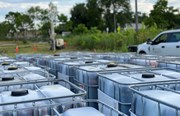How Does ISTR Work on Petroleum Impacted Sites?
By: CascadeHigh mass petroleum hydrocarbon impacted sites present a unique challenge in environmental remediation, as they are often resistant to conventional in situ treatment methods. The main limitation for most technologies at these sites is their inability to treat the large spectrum of contaminant species and their inherent physio-chemical properties, varying from BTEX to PAHs. To further complicate remedial efforts, these complex mixes of petroleum species can exist in various phases in the subsurface, including; aqueous, non-aqueous (LNAPL & DNAPL), and as mass sorbed to the soil matrix.
Electrical Resistance Heating (ERH), Thermal Conduction Heating (TCH), and Steam Enhanced Extraction (SEE) are the three in situ thermal remediation (ISTR) technologies available in the marketplace that have been shown to effectively remediate the entire range of petroleum hydrocarbons at contaminated sites down to MCLs, even ones with complicated hydrogeologic features and complex contaminant plumes. All three of these technologies have been successfully applied to hydrocarbon impacted sites, ranging from historic gas station spills impacted with LNAPL to former Manufactured Gas Plant (MGP) sites with appreciable quantities of coal tar and creosote LNAPL and DNAPL.
Based on site-specific subsurface conditions and overall remedial goals, one or more of these ISTR technologies may be used to treat petroleum impacts under three typical treatment strategies and target temperatures:
1. LOW-TEMPERATURE TREATMENT OPTIONS (30 TO 70°C) ERH, TCH AND SEE
Heat Enhanced Free Product Extraction (DNAPL, Pumpable Fluids)
Petroleum-impacted sites featuring high mass and viscous NAPL may be effectively treated using a lower temperature heat-enhanced free product extraction strategy. Combining a moderate heating strategy (30 to 70°C) with multi-phase extraction (MPE) promotes desorption of mass from the soil matrix, reduces viscosity of NAPLs and free products, ultimately increasing mobility in the subsurface and overall pumpability/extraction.
Heat Enhanced Bioremediation
Petroleum hydrocarbon can be effectively treated by aerobic heat-enhanced bioremediation strategies at temperatures between 25 and 35⁰C. Sites that typically benefit from a heat-enhanced bioremediation strategy are diffuse lower concentration plumes existing in the saturated zone. Heat enhanced bioremediation strategies are often combined with oxygen injection wells to maintain aerobic conditions, and heat-enhanced (Soil Vapor Extraction (SVE) or Dual Phase Extraction (DPE) operations to maximize contaminant removal.
Heat Enhanced SVE (BTEX, TPH-g)
At moderate to low temperatures (30 to 80°C), some petroleum hydrocarbon species can be removed from the subsurface, albeit at varying efficacies, through heat-enhanced SVE operations. Increases in the vapor pressure of VOCs and short to mid chained aliphatic hydrocarbons occur during low-temperature ISTR, engendering higher contaminant extraction rates, and a significant reduction in the remediation timeline when compared to traditional SVE completed at ambient temperatures.
2. MID-TEMPERATURE TREATMENT OPTIONS (100°C) ERH, TCH, SEE
Gas Station Sites – VOCs, lighter end SVOCs, TPH-g, BTEX, LNAPL, DNAPL
At elevated temperatures, the boiling point of the entire range of petroleum hydrocarbons present at a site drop significantly in the presence of groundwater and soil moisture (Henry’s law, and azeotropic boiling points). This allows lighter end hydrocarbons (generally C2 through C12) to transition to vapor phase at temperatures up to 100°C, while the heavier hydrocarbons are entrained through in situ steam generation and removed from the subsurface by vapor extraction.
In situ steam generation can also reduce concentrations of mid-weight range petroleum hydrocarbons, monoaromatic hydrocarbons (BTEX) and naphthalene concentrations as the vapor pressure of the contaminant constituents increase tremendously, increasing evaporative transfer to the air stream. During boiling, the mass fraction of hydrocarbons in steam typically increases by an order of magnitude higher than its mass fraction in water. As such, the fractionation process during in situ steam generation exponentially drives down concentrations in groundwater.
Heavy petroleum constituents (C20 and higher) typical of diesel range organics and many PAH compounds can be removed from soil and groundwater in the vapor phase at these temps, however, only in a limited capacity. However, decreasing DNAPL viscosity (up to two to three orders of magnitude), and increased contaminant desorption, make VOC and SVOC removal through MPE extremely efficient at these temperatures.
MGP/Creosote Sites - VOCs, limited SVOCs, LNAPL, DNAPL, Naphthalenes
During 100°C ISTR applications at these sites, VOCs and restricted lighter-end SVOCs are removed from the subsurface, while immobile, non-leachable, contaminant fractions are left behind with limited impacts to groundwater quality, through a process EPRI has termed In Situ Thermal Solidification. Remaining SVOC and higher end coal tar/MGP residues are solidified, stabilized and are no longer mobile in the subsurface as a NAPL material.
3. HIGH-TEMPERATURE OPTIONS (100 TO 325°C) TCH ONLY
- VOC & SVOC removal (TPH-mo, TPH-d)
- PAHs, dioxin
Target temperatures typically range from less than 200°C for complete removal of naphthalene, to 335°C for treatment of high molecular weight PAHs, including B(a)P, PCB and dioxins.
At sites where dewatering is an option, high-temperature applications allow ISTR technologies to reach low cleanup standards for the entire range of petroleum hydrocarbon impacted sites. These sites include; gas station sites impacted with TPH-g and BTEX; leaking UST sites featuring TPH-g, TPH-d, and oil range organics; LNAPL and DNAPL impacted sites; as well as MGP sites with high SVOC contaminant mass. Of the three heating techniques, only TCH is able to reach subsurface temperatures above the boiling point of water. Other than the enhanced volatilization due to the higher temperatures, oxidation and pyrolysis reaction may also contribute to the mass removal processes.
TerraTherm offers ISTR solutions for almost all petroleum impacted sites, offering efficient, reliable solutions capable of reaching site closure in a matter of months rather than years or decades, increasing the overall return on remediation investment.

